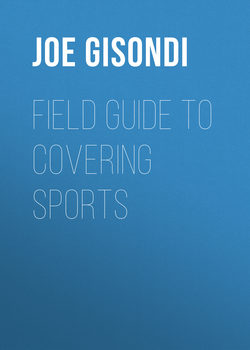Читать книгу Field Guide to Covering Sports - Joe Gisondi - Страница 26
На сайте Литреса книга снята с продажи.
Context and Analysis
ОглавлениеTell the reader what this game means. Has a team broken an eight-game losing streak? Qualified for sectionals? Lost its fourth straight five-set volleyball match? Earned a berth in a championship?
Sports Insider: Headline: Bolster Your Resume With Game Coverage
1 Focus on getting beat experience. The more the better. Start small, build up to the major beats at your school.
2 To be a successful beat reporter, one of the keys is showing up. Don’t just cover the games. Show up at practice, even when you are not scheduled to write. The more the coaches and players see you, the more they will trust you and reveal themselves.
3 Write tight. Get to the point quickly. 500-word stories are becoming the norm, so it’s no longer OK to write two paragraphs of prose to set up the lead of the story. A good way to check yourself is to write a headline based on the first two paragraphs of your story.
4 When choosing your postgame sidebar, instead of focusing on a particular player, look for stories that focus on a key moment or key decision that helped turn the result.
5 Don’t take the summer off. Find an internship. Start looking in September. Many deadlines are in November/December.
—Bill Hill, assistant managing editor at MLB.com
Break down games into smaller parts, such as scoring runs in basketball, key drives in football, or key at-bats in softball or baseball. For example, you might notice that a basketball team played better with a smaller lineup, going on scoring runs of 12–2 and 10–0 when the starting center was on the bench. You might notice that a soccer team dominated the middle of the field for most of the game, which will allow you to focus on the play of the center midfielders and backs and describe their efforts during these key moments. You might compare the number of running plays with the number of passing plays by each football team during the game or a key series or by each half of the game. Why did the teams run more in the second half? You could also assess how well a team ran power plays in hockey. Why did a team struggle despite having a one-man advantage? For baseball, you should address pitch selection and pitch counts. Did a pitcher rely too heavily on fastballs, especially when he was behind in the count? Or did a team hit more grounders than fly balls?
Don’t forget to convey what happens next. Has the team advanced to the next level of a state playoff? Include this information high in a story. Where does the team play next during the regular season? That detail can wait for later.
Here are some more examples:
▸ “With Kansas’ 63–21 loss to Texas Tech, MU moved into a first-place tie in the Big 12 North with the Jayhawks by dismantling its second North opponent in as many tries this season. Mizzou previously beat Nebraska 52–17.”6
▸ “Gaudin allowed a leadoff single and walked the next hitter, but escaped the inning with a ground out, a strikeout and a fly out. His sinkers and sliders moved all over, several bouncing in front of catcher Jose Molina. One hit a batter, another was a wild pitch, and three times Oakland moved a runner to third.”7
▸ “Seattle doesn’t game plan for its exhibition opponents, and the Broncos ran a heavy diet of screen plays and short routes. Their longest play of the first half was a 26-yard completion to Eddie Royal on a bubble screen.”8
▸ “The offense is being helped this year by a couple of things, and maybe they’re obvious. One: The inside players have the ability to step away from the basket and be threats unlike the center who clogged the middle in recent years. Although he didn’t do it Saturday, center Mike Tisdale has shown great confidence in his mid-range jumper and so has forward Mike Davis. That opens a lot of space to get things done. Two: The Illini start three guards who have played the point at various times. Trent Meacham, Demetri McCamey and Chester Frazier can all pass the ball effectively and their assist numbers reflect the fact that sometimes they have three point guards on the court simultaneously.”9
